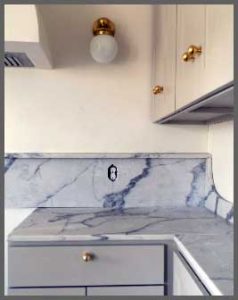In the realm of engineered stone, COMPAC quartz has long held a reputation as a high-quality product. Yet, as is the case with any material, it comes with its own set of advantages and disadvantages.
Let’s delve into the world of COMPAC quartz and unravel its nuances in an easy-to-understand, relatable manner.
An Overview of COMPAC Quartz
From its conception in 1975, COMPAC has been a leading player in the market of engineered quartz surfaces. Born in Spain, this unique product has made its way into homes and commercial properties all around the globe, enchanting onlookers with its robust nature and aesthetic appeal.
The Pros of COMPAC Quartz

What makes COMPAC quartz a cherished choice among homeowners and interior designers alike? Here’s the scoop.
- Durability that Speaks for Itself
First off, the durability of COMPAC quartz is unquestionable. The product’s composition—93-95% natural quartz and 5-7% polymer resin—results in a sturdy and highly resistant material. It endures everyday use and abuse like a champ, shrugging off scratches, stains, and heat.
- A Color Palette to Die for
From cool whites to warm browns and vibrant blues, COMPAC’s color range is as diverse as it is delightful. This impressive array allows for versatile design schemes, offering something for everyone.
- Easy Maintenance
Lastly, COMPAC quartz requires minimal upkeep. Just a quick wipe with a mild detergent, and it’s good as new. There’s no need for sealants, making it a truly low-maintenance option.
The Cons of COMPAC Quartz

While the pros are undeniable, there are also a few downsides to consider when evaluating COMPAC quartz.
- Cost Implications
While COMPAC quartz offers robustness and longevity, these attributes come at a cost. This material is relatively pricey compared to some other countertop materials.
- Not Completely Natural
Another drawback for some is that COMPAC quartz is not entirely natural. While it is made predominantly from quartz—a natural substance—the inclusion of polymer resins means it can’t claim 100% natural status.
- Susceptibility to Direct Sunlight
Lastly, like other engineered quartz products, COMPAC surfaces can discolor over time when exposed to continuous direct sunlight.
Read More: About Allen Roth Quartz
Frequently Asked Questions About COMPAC Quartz
Indeed, COMPAC is considered one of the top quartz brands in the market. It’s well-loved for its durability, wide range of colors, and ease of maintenance.
COMPAC quartz originates from Spain. Since its inception, it has become an internationally recognized brand, supplying its products to various parts of the world.
Determining the most realistic quartz brand largely depends on individual preferences. However, brands like COMPAC, Caesarstone, and Silestone often come up due to their unique patterns and textures that closely mimic natural stone.
A COMPAC countertop refers to a countertop surface made from COMPAC quartz—an engineered stone comprised of a high percentage of natural quartz and a small percentage of polymer resin.
The best grade of quartz depends on its intended use. For countertops, high-quality engineered quartz like COMPAC is often favored due to its superior durability and aesthetic appeal.
In the realm of natural quartz, gem-quality quartz, also known as rock crystal, is considered the highest grade. However, for countertops and other surfaces, high-end engineered quartz brands like COMPAC are often regarded as the highest grade.
The Verdict on COMPAC Quartz: A Blend of Practicality and Aesthetics
As we reach the tail-end of our comprehensive COMPAC Quartz review, we find ourselves balancing on a seesaw of pros and cons. Yes, COMPAC quartz is durable, diverse in its color range, and easy to maintain. However, it also carries a higher price tag, isn’t completely natural, and can discolor under prolonged exposure to sunlight.
Yet, it seems that the pros do outweigh the cons for many homeowners and designers. The sheer durability of COMPAC quartz, coupled with its extensive color palette and low maintenance requirements, appears to vindicate its higher cost. Also, the non-natural component—a small proportion of polymer resin—is the very thing that gifts it with its strength and resilience. As for its susceptibility to sunlight, it’s easily mitigated by choosing a location out of direct, continuous sunlight or using window treatments to limit exposure.
Thus, from an analytical perspective, COMPAC quartz seems to be a solid choice for those seeking a balance of practicality and aesthetics. It offers the charm and robustness of a natural stone with the added benefits of modern engineering. Whether it’s the centerpiece of a cozy, family kitchen or gracing the bathrooms of a commercial building, COMPAC quartz delivers both functionality and visual appeal.
Read More: About Pompeii Quartz
COMPAC Quartz: More Than Just a Pretty Surface
The journey of COMPAC quartz from the landscapes of Spain to households worldwide has been nothing short of impressive. Today, it stands as a testament to what can be achieved when the brilliance of nature is married with human ingenuity. And while no material is without its drawbacks, COMPAC quartz holds its own admirably, offering a harmony of strength, beauty, and convenience that few other surfaces can claim.
In the end, the decision of whether COMPAC quartz is the right choice for you will depend on your specific needs, preferences, and budget. After all, every home and every homeowner is unique. But if you’re looking for a material that brings the best of the natural and engineered worlds into your space, COMPAC quartz is certainly worth considering.
It’s Your Turn Now
So, here we are—closing the chapter on our COMPAC Quartz review. We hope it’s been informative and insightful, helping you better understand the ins and outs of this unique material. Now, it’s your turn to evaluate, analyze, and decide whether COMPAC quartz will find its way into your next renovation project. We wish you the best of luck in creating your perfect space!



